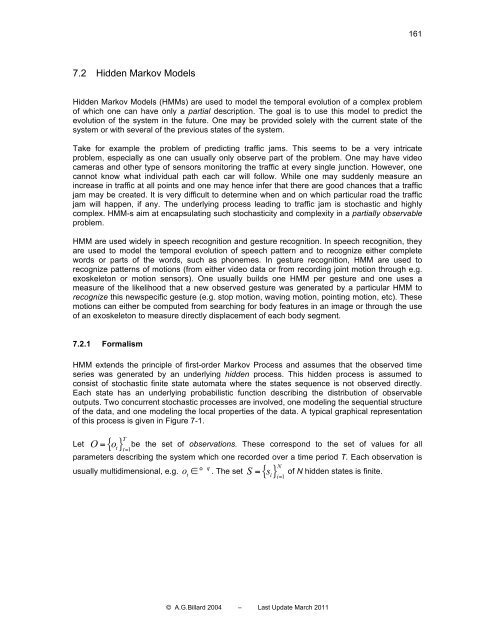MACHINE LEARNING TECHNIQUES - LASA
MACHINE LEARNING TECHNIQUES - LASA
MACHINE LEARNING TECHNIQUES - LASA
Create successful ePaper yourself
Turn your PDF publications into a flip-book with our unique Google optimized e-Paper software.
161<br />
7.2 Hidden Markov Models<br />
Hidden Markov Models (HMMs) are used to model the temporal evolution of a complex problem<br />
of which one can have only a partial description. The goal is to use this model to predict the<br />
evolution of the system in the future. One may be provided solely with the current state of the<br />
system or with several of the previous states of the system.<br />
Take for example the problem of predicting traffic jams. This seems to be a very intricate<br />
problem, especially as one can usually only observe part of the problem. One may have video<br />
cameras and other type of sensors monitoring the traffic at every single junction. However, one<br />
cannot know what individual path each car will follow. While one may suddenly measure an<br />
increase in traffic at all points and one may hence infer that there are good chances that a traffic<br />
jam may be created. It is very difficult to determine when and on which particular road the traffic<br />
jam will happen, if any. The underlying process leading to traffic jam is stochastic and highly<br />
complex. HMM-s aim at encapsulating such stochasticity and complexity in a partially observable<br />
problem.<br />
HMM are used widely in speech recognition and gesture recognition. In speech recognition, they<br />
are used to model the temporal evolution of speech pattern and to recognize either complete<br />
words or parts of the words, such as phonemes. In gesture recognition, HMM are used to<br />
recognize patterns of motions (from either video data or from recording joint motion through e.g.<br />
exoskeleton or motion sensors). One usually builds one HMM per gesture and one uses a<br />
measure of the likelihood that a new observed gesture was generated by a particular HMM to<br />
recognize this newspecific gesture (e.g. stop motion, waving motion, pointing motion, etc). These<br />
motions can either be computed from searching for body features in an image or through the use<br />
of an exoskeleton to measure directly displacement of each body segment.<br />
7.2.1 Formalism<br />
HMM extends the principle of first-order Markov Process and assumes that the observed time<br />
series was generated by an underlying hidden process. This hidden process is assumed to<br />
consist of stochastic finite state automata where the states sequence is not observed directly.<br />
Each state has an underlying probabilistic function describing the distribution of observable<br />
outputs. Two concurrent stochastic processes are involved, one modeling the sequential structure<br />
of the data, and one modeling the local properties of the data. A typical graphical representation<br />
of this process is given in Figure 7-1.<br />
T<br />
O o =<br />
= be the set of observations. These correspond to the set of values for all<br />
Let { t} t 1<br />
parameters describing the system which one recorded over a time period T. Each observation is<br />
usually multidimensional, e.g.<br />
q<br />
N<br />
ot<br />
∈ ° . The set S { s i }<br />
i= 1<br />
= of N hidden states is finite.<br />
© A.G.Billard 2004 – Last Update March 2011

















